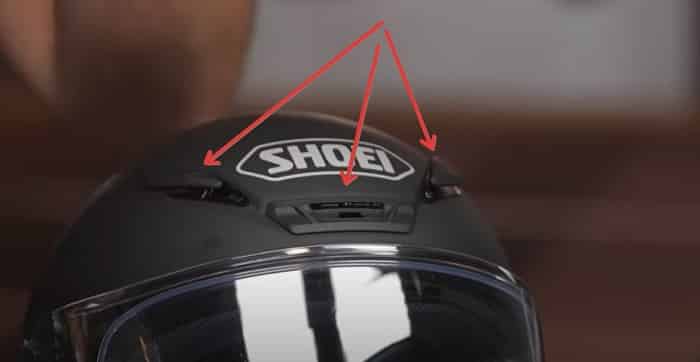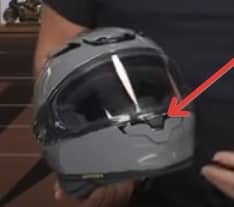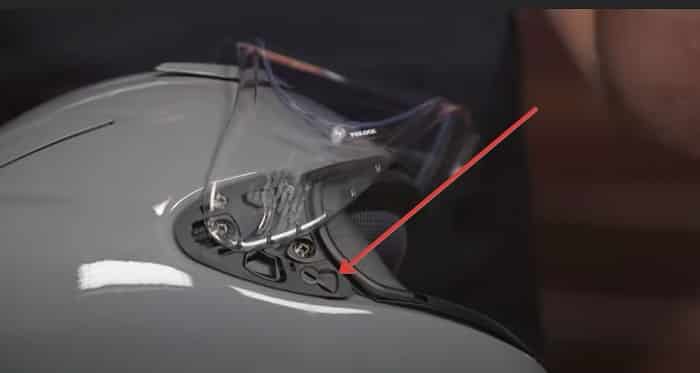Deprecated: mb_convert_encoding(): Handling HTML entities via mbstring is deprecated; use htmlspecialchars, htmlentities, or mb_encode_numericentity/mb_decode_numericentity instead in /home/u598013642/domains/motorcyclegear101.com/public_html/wp-content/themes/acabado/functions.php on line 2160
Deprecated: mb_convert_encoding(): Handling HTML entities via mbstring is deprecated; use htmlspecialchars, htmlentities, or mb_encode_numericentity/mb_decode_numericentity instead in /home/u598013642/domains/motorcyclegear101.com/public_html/wp-content/themes/acabado/functions.php on line 2160
Seven years ago, the RF line was launched and quickly became the baseline for most helmets. It’s Shoei’s most decorated helmet in their lineup. Even though it’s one step down from the X-14, the RF-1400 is now their lightest and most compact full-face helmet that Snell and D.O.T fully approve.
So how does Shoei go about changing and updating such a revolutionary helmet? Very carefully, and that’s what you’ll see with the RF-1400.
Shoei RF-1400 Helmet
We’re going to break down all the updates and changes you’ll see between the two, and we’ll give you our thoughts on how that correlates to the helmet’s performance.
| Details | Shoei RF-1400 Helmet |
| Price | From $599 |
| Weight | 2lbs 9 oz |
| Shape | Intermediate Oval |
| Safety Rating | Snell |
| Shell Construction | AIM’s plus |
Shoei RF-1400 Price
The price will come in around $499, so we might as well round up to that $500 mark. But we do not see a huge price increase in solid colors. The outgoing helmets are around $485, so the price isn’t increasing too much, roughly about $15.

Shoei RF-1400 Shell Construction
The shell construction itself has stayed the same. It’s that AIM’s plus shell, which is the advanced integrated matrix plus shell from Shoei.
That’s the material that they hold the knowledge on. But it is the same construction we saw with the RF-1400 or the RF-1200, so there are no real changes.
Shoei RF-1400 Shell Sizes
There are four different shell sizes. The advantage of having so many different shell sizes is that smaller helmets look smaller and fit smaller if you are a smaller person, and larger helmets then scale up in size. it also helps to reduce weight on the lower end of the spectrum, so you’re not using an extra-large shell on a small helmet,
the shell size breakdown runs from extra small, small for the first one, then an independent shell for medium, an independent shell for large, and then extra-large 2XL gets its own shell size.
Shoei RF-1400 Safety Rating
It is now snell 2020, so snell 2020 rating on this.
Shoei RF-1400 Weight
It comes in at 3lbs 9 oz in a medium. If you are an RF-1200 rider, you’re familiar with the outgoing helmet. It is a three-ounce increase. So we asked Shoei, where did the added weight come from?
Their answer was that they’d reinforced the EPS liner on the side of the head for better impact protection, and what you’ll notice as we work our way through this, the cheeks are going to feel a bit snugger.
Part of that is the contour of the cheek pad, but also part of that is the fact that they have beefed up the side protection on this particular helmet. How that translates to the helmet, we will get to that in one second.

Shoei RF-1400 Fit
For those unfamiliar with the outgoing RF-1200, the fit stays the same: intermediate oval, a little bit longer front to back, and narrower down the side of the head.
What we loved about the RF-1400 is that it fits about 80 percent of the population. People would call in the CS and say, “I need a great all-around helmet, and I need it to fit right out of the box.”
99% of the time, they will get a recommendation to at least check out the RF-1200, and 80% of the time, it will work. It will work for the majority of the riders out there in the American market, and that’s one of the reasons it’s become so popular.
Shoei did adjust the fit a bit as it sits around the cheek pads. It is a little bit snugger to get the helmet on and off. Once the helmet is on, it will sit snugly against your cheeks. It makes it more comfortable when you’re riding. You don’t feel like the helmet’s flexing around you as much.
It would be best if the helmet fit nicely and snugly on your cheeks. We always used to say it’s like when your aunty comes to town, and she pinches your cheeks. It does become important when we talk about the fit changes to this particular lid.
Shoei RF-1400 Aerodynamics
According to their claims, Shoei has made the helmet more aerodynamic. They reduced drag by four percent and lift by six percent, even though it’s got a three-ounce weight change.
It feels a bit lighter, you can ride all day, and it does not feel heavier on the road. The example I’ll give you is that the Shoei VFX Evo, on the dirt side of things, is almost four pounds, and out of all the dirt helmets I’ve used, that’s my favorite go-to.
Shoei does do a good job of making the helmets. Even though you throw them on a scale, they look heavy on paper; they do translate to a bit of a lighter feel when they’re out on the road.
A lot of that again is going to come to the aerodynamic change. Looking at this from a profile side point, the back spoiler has slimmed down slightly; it is a bit more aerodynamic.
Shoei RF-1400 Exterior Vents
The big change you will notice as we talk about the vents is that the front vent has changed. So you no longer have this little area right here, which kind of creates friction with the wind flow over the top.
They’ve gone to more of this slider design, which is very similar to what we’ve seen on the GT-A R 2 or the Neotec 2, making it a lot easier to use.

Shoei RF-1400 Airflow
One of the criticisms of the RF-1200 was the airflow. The airflow was not good, but once you open the two vent sliders on the front, it was a pain in the butt to slide it back and forth, especially with motorcycle gloves on while you’re riding.

They’ve simplified the design of the new helmet. It is similar to what you would see on the GT-Air 2 or the Neotec 2. It’s very easy to feel if the vents are open or closed, especially if you are wearing gloves.
The other thing that they’ve done is they’ve increased the vents. They’ve gone to two openings on the top; this helps to push airflow through the front end.
Then they’ve increased the exhaust vent by nearly 50 percent so that air pushing through from the front has a much easier way of escaping now.
The one thing to note here is that the vent used to be an active vent, which means you could close that off in colder weather.
Again, part of the problem was that one of their main complaints was that it was really hard to figure out whether the vent was open or closed.
Especially if you were riding along and you reached around to feel that there wasn’t a progressive way of saying, okay, that is clicked open or it’s click closed.
This new one is a passive vain, which means it’s always open. It’s not a huge concern for me because, even if you’re riding in colder weather, you can close the front vents, and that’s where the air is pushing in.
One thing to note is that this vent on the back is now passive, but it is a lot larger, which will help for riding in the summer months.
Looking at the front, you’ll notice that the front vent change is twofold.
The vent design has changed slightly, and you push it down to open it up. One thing to note here is that the face shield opening has moved to a button design on the front.

I’ve critiqued this on some other helmets that we’ve used. Some of the other helmets have a better design. If you’re looking at something like the AGV K6, it’s more of a clear push, click pop open.
With this, it’s a little bit trickier to get it open. It’s not a push; you have to push in, and it doesn’t pop up. You have to push in and then push the visor up.
It makes it a little complicated when you’re trying to either open the vent in the front or push it open. The old one had a clear design on the side where you pushed the latch up and opened it.
As far as the detents, there are nice solid detents with this. When you open it to the full position, it does lock into that wide-open position.
Shoei RF-1400 Face Shield
The face shield story is another one of the major changes they’ve improved the facial quite a bit. It’s now a CWRF2 face shield. They’ve taken a lot of the technology from their 14 lines that Marc Marquez has been using, and you’ll see the little vortex generators over on the face shield. Again to help spoil the air, that adds to the aerodynamics.
Shoei RF-1400 Pinlock
The other thing you’ll note is the pinlock insert is now much larger, about a 10% increase on the pin lock insert. If you’re not familiar with a Pinlock, a Pinlock is a little liner that sits on the inside of the face shield.
It comes standard in the box on this particular helmet, and when you insert it, it helps in colder temperatures or just general fogging. If you breathe heavily and your helmet is all sealed up on a cold morning, you don’t need to worry about the fogging inside the face shield.
They have also improved the line of vision. So when you’re using the facial, it’s much easier to see out without any distortion in your peripheral – and it is a vast improvement over the previous version.
The other thing you’ll also see is that while the design for getting the visor on and off is the same, you have the little lever that pulls down and pops off. You’ll notice the little switch. This was on the previous version, but it was like a screw head you had to turn.

You can switch it, and it pulls the face shield in snugger to the gasket. That makes it adjustable with a good fitment for how that will work for the gasket on your helmet.
The gasket on the previous version was a one-piece gasket. It has improved a little, the ceiling around the face shield; there are no gaps. We like to take a little post-it note and try to run it in there to see any gaps along with the gasket; we couldn’t find any.

We like the redesign of the face shield on this helmet, except for that center release. That’s not going to be favorable for many people, especially if you’re trying to do that with motorcycle gloves. Again, this is a minor nitpick for all the positives we saw with the face shield redesign.
When you look at the side of this helmet, you’re going to notice that the padding has been redesigned.
The EPS has a little bit more EPS. From a protection standpoint, Shoei tells you that this is a little bit of added benefit for the head’s side. The downside was when we installed a com system; it pushed the gasket.
It put a little bit of pressure on the gadget, and you’ll probably feel it pushing against the left cheek pad a little bit. So keep that in mind.
One of our nitpicks is that you’re going to have to use a sticky mount. Shoei will have a little adapter mount to which you can mount your com system, but if you’re trying to use your clamp system regularly, you can get it in there. It’s just not going to be the smoothest solution possible.
Shoei RF-1400 Noise Reduction
Let’s throw this out in the open. I think noise reduction is very specific to individual riders. One of the biggest questions we get is, is the helmet quieter? Is this helmet any noisier? It’s subjective.
Helmet noise doesn’t bother me at all. I can go out on the highway and usually use earplugs, so I can’t say you know that you will find this helmet quieter.
I can tell you that with us riding in it, the RF-1400 is no quieter than the RF-1200. I’m not going to say it’s noisier, but it’s not quieter.
The one thing to note here is that to maximize the helmet’s ability to be as quiet as you want, it is designed to be used with the chin skirt. Okay, I’m not too fond of a chinstrap.
It makes it a little bit trickier to get in and out of the helmet, |I remove it. It is removable, but for those out there trying to reduce as much noise as possible, you will want to use the helmet with the chin skirt installed.
Shoei RF-1400 Cheek Padding
The other thing you’ll note is the design on the bottom has changed; you have a snugger fit. The contour of the cheek pad has more padding. It gives it a better seal around the bottom of the helmet, giving you less airflow pushing up from the bottom.
What that means for you when you’re taking the helmet on is you’re going to have to pull it apart a little bit harder with that chin strap to get in on and off. Once you have it on, you will notice that the cheek pads are a little bit snugger than the previous version of the RF-1200.
Once you have the helmet on, it’s a much more comfortable helmet. There’s a better contour to the cheek pad; you have less airflow pushing up from below, so it is a slightly snugger fit, but it will be better.
When you’re rolling down the highway, it will help to hold the helmet in place just that much better. There’s no change to the internal crown, and that’s where you get the sizing.
Shoei RF-1400 Quick Release System
You still get the quick emergency cheek pad system, so if you need to pull it out, you can get in an emergency in a crash. The EMT’s can get that out right away.
Shoei RF-1400 Interior Venting
Once you have removed the headliner, you will see the improved interior venting system. While it doesn’t look like there are cutouts or channels for airflow, which is something I would need in a helmet, they’re behind the first layer of EPS.
The venting runs through a hidden layer pushing the airflow through holes cut into the EPS liner. The air then goes to that larger exhaust vent at the back of the helmet. Again, small refinements we see across the board help make the helmet a little more ventilated.

Shoei RF-1400 Comm System Integration
When the RF-1200 was introduced, it was one of the first helmets to standardize removable pods for comms systems. A lot of stuff is integrated into helmets, such as speaker cutouts and Pinlock’s that are now included in the box. That didn’t exist eight or nine years ago.
When Shoei brought this to the table, they led the charge with many of these evolutions, which continued in this helmet.
In Conclusion
This is not the same revolutionary helmet we saw with the RF-1200. It didn’t break the mold, but I didn’t have to. The RF-1200 is still, to this day, one of the best-selling helmets on the market, and they didn’t want to alienate those people.
What they did was they took the RF-1200, and they addressed some of the issues that riders have had with it. A fair critique would be the button at the front of the face shield, the fact that it did get slightly heavier.
Shoei claimed that part of that weight was added to the EPS. I would have assumed they would keep the weight at least the same or maybe reduce it slightly.
But then you can look at some of the pros. The aerodynamics have improved. The helmet feels more stable while you’re riding. Those cheek pads do make it more comfortable to ride in.
The venting is vastly improved. The venting on this one is now one of the best in this category.
If you are an RF-1200 user and your helmet is getting a little bit long in the tooth, you want to upgrade. I think you’re going to be very comfortable in an RF-1400. It’s going to feel like home, but maybe a slightly nicer home.
There are a lot of riders out there utilizing RF-1200s and RF-1400s. I would encourage you to read other rider reviews from folks putting this helmet through its paces.
Where To Buy
There are lots of retailers online, but my favorite is Revzilla.com . They ship worldwide and also offer a price match guarantee so click here for the best price on the Shoei RF-1400
. They ship worldwide and also offer a price match guarantee so click here for the best price on the Shoei RF-1400 .
.


